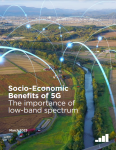 A very brief post today in order to highlight a new report from GSMA, “Socio-Economic Benefits of 5G: The importance of low-band spectrum” [pdf, 8.9MB].
A very brief post today in order to highlight a new report from GSMA, “Socio-Economic Benefits of 5G: The importance of low-band spectrum” [pdf, 8.9MB].
The report was released last week as GSMA set out its vision for the ITU’s upcoming World Radiocommunications Conference (WRC2023), taking place at the end of the year in Dubai.
GSMA says the importance of low-band spectrum is because of the propagation characteristics of such frequencies. Low-band spectrum is particularly well suited for providing coverage in rural and remote areas. In addition such frequencies have better in-building penetration, providing ‘deep’ indoor coverage as well as capacity in urban areas.
Low-band spectrum is a driver of digital equality, reducing the gap between urban and rural areas and delivering affordable connectivity. Without sufficient low-band spectrum, the digital divide is likely to widen, and those living in rural areas will be excluded from the latest digital technologies.
The report has an interesting comparison of indoor 5G signal strength in the largest cities in Australia, Canada and Japan. Look for Figure 12 in the report.
As WRC-23 approaches, we will likely be hearing more about spectrum policy.
